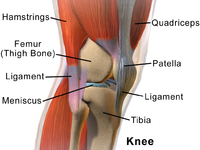
Photo from wikipedia
To evaluate the acoustic emissions (AE) and kinematic instability (KI) of the osteoarthritic (OA) knee joints, and to compare these signals to radiographic findings. Sixty-six female and 43 male participants… Click to show full abstract
To evaluate the acoustic emissions (AE) and kinematic instability (KI) of the osteoarthritic (OA) knee joints, and to compare these signals to radiographic findings. Sixty-six female and 43 male participants aged 44–67 were recruited. On radiography, joint-space narrowing, osteophytes and Kellgren–Lawrence (KL) grade were evaluated. Based on radiography, 54 subjects (the study group) were diagnosed with radiographic OA (KL-grade ≥ 2) while the remaining 55 subjects (KL-grade < 2) formed the control group. AE and KI were recorded with a custom-made prototype and compared with radiographic findings using area-under-curve (AUC) and independent T-test. Predictive logistic regression models were constructed using leave-one-out cross validation. In females, the parameters reflecting consistency of the AE patterns during specific tasks, KI, BMI and age had a significant statistical difference between the OA and control groups (p = 0.001–0.036). The selected AE signals, KI, age and BMI were used to construct a predictive model for radiographic OA with AUC of 90.3% (95% CI 83.5–97.2%) which showed a statistical improvement of the reference model based on age and BMI, with AUC of 84.2% (95% CI 74.8–93.6%). In males, the predictive model failed to improve the reference model. AE and KI provide complementary information to detect radiographic knee OA in females.
Journal Title: Scientific Reports
Year Published: 2021
Link to full text (if available)
Share on Social Media: Sign Up to like & get
recommendations!